Transformation Planning for Resilient Wildlife Habitats in Ecotourism Systems
Abstract
:1. Introduction
2. Literature Review
2.1. Ecotourism Systems
2.2. The Link between Systems Thinking and Transformation Planning
3. Methods and Materials
3.1. Transformation Planning Process with Systems Thinking
3.1.1. Discovery of Dynamic Problems
3.1.2. Identification of Causal Relationships among the Main Variables
3.1.3. Analysis of the Structures and Behaviors of the Ecotourism System
3.1.4. Transformation Plans for Resilient Wildlife Habitats
3.2. Study Area
3.3. Data Collection
4. Results and Discussion
4.1. Discovery of Dynamic Problems in Eulsukdo’s Ecotourism System
4.2. Causal Relationships among the Main Variables in Eulsukdo’s Ecotourism System
4.3. Structures and Behaviors of Eulsukdo’s Ecotourism System
4.3.1. The Business Field of the Ecotourism System
4.3.2. The Environmental Field of the Ecotourism System
4.3.3. The Economic Field of the Ecotourism System
4.3.4. The Social Field of the Ecotourism System
4.3.5. The Whole Eulsukdo Ecotourism System
4.4. Transformation Plans for Resilient Wildlife Habitats
5. Conclusions
Acknowledgments
Author Contributions
Conflicts of Interest
Abbreviations
| SES | Social-Ecological System |
| CLD | Causal Loop Diagram |
| R | Reinforcing loop |
| B | Balancing loop |
| NGO | Non-Governmental Organization |
| ID | In-depth interview |
| MR | Monitoring Reports |
| NA | News Articles |
| LR | Literature Review |
| RJ | Researcher’s Judgment |
Appendix A
| Field | Main Variables | Explanation | Observed Trend | Desired Trend through Transformation Planning |
|---|---|---|---|---|
| Business | Deregulation of protected areas | The deregulation of protected areas indicates that the local government of Busan has made environmental regulations less strict to develop protected areas in Eulsukdo. |  |  |
| Tourism infrastructure | A tourism infrastructure has been built in Eulsukdo for tourism, such as roads, amenities, cultural facilities, parks and trails. |  |  | |
| Experience programs | Experience programs are the number of environmental education activities that have been designed and conducted by the Nakdong Estuary Eco-Center to improve tourists’ interests in Eulsukdo. |  |  | |
| Tourist interest | Tourist interest is a variable to indicate the standard of interest of Eulsukdo, where tourists visit. |  |  | |
| Number of tourists | The number of tourists refers to how many people visit Eulsukdo for tourism. |  |  | |
| Wildlife habitats | Wildlife habitats are areas with food, water, cover, and space for wildlife in Eulsukdo. |  |  | |
| Ecotourism revenue | Ecotourism revenue refers to the amount of local income from ecotourism, such as programs for feeding migratory birds. |  |  | |
| Benefits to the local community | Benefits to the local community include environmental, economic, and social benefits that local residents could receive. Environmental benefits include a sound residential environment and improved wildlife diversity. Economic benefits include the local residents’ incomes, and social benefits refer to a sense of community and fellowship. |  |  | |
| Environment | Lack of natural food sources for migratory birds | A lack of natural food sources for migratory birds indicates insufficient food, such as Scirpus planiculmis Fr. Schm., for migratory birds. |  |  |
| Artificial food supply | Foods such as sweet potatoes have been artificially provided through programs to feed migratory birds. ‘Artificial food supply’ indicates the amount of food that humans provide annually. |  |  | |
| Wildlife habitats | Wildlife habitats are areas with food, water, cover, and space for wildlife in Eulsukdo. |  |  | |
| Economy | Ecotourism revenue | Ecotourism revenue refers to the amount of local income from ecotourism, such as programs for feeding migratory birds. |  |  |
| Benefits to the local community | Benefits to the local community include environmental, economic, and social benefits that local residents could receive. Environmental benefits include a sound residential environment and improved wildlife diversity. Economic benefits include the local residents’ incomes, and social benefits refer to a sense of community and fellowship. |  |  | |
| Investment of profitable resources | The investment of profitable resources is a method to distribute money that would be used for the benefit of local residents. In this paper, the decision maker could select two businesses that are preserving wildlife habitats for ecotourist business and building cultural facilities for cultural projects. |  |  | |
| Wildlife habitats | Wildlife habitats are areas with food, water, cover, and space for wildlife in Eulsukdo. |  |  | |
| Tourist interest | Tourist interest is a variable to indicate the standard of interest of the places where tourists visit. |  |  | |
| Number of tourists | The number of tourists refers to how many people visit Eulsukdo for tourism. |  |  | |
| Cultural facilities | The cultural facilities in Eulsukdo include places such as the Nakdong Estuary Eco-Center, Theme Parks, and Eulsukdo Culture Hall |  |  | |
| Satisfaction of local residents | The satisfaction of local residents is the standard for the degree to which local residents are satisfied by cultural projects, such as concerts, exhibitions, and art training courses. |  |  | |
| Utilization of local residents | The utilization of local residents refers to the number of local residents who use all types of cultural facilities. |  |  | |
| Cultural facilities revenue | Cultural facilities revenue refers to the income from cultural facilities through concerts, exhibitions, and art training courses. |  |  | |
| Society | Government-initiated management | Government-initiated management is a variable regarding whether ecotourism management systems are led by the local government without other stakeholders. |  |  |
| Wildlife habitats | Wildlife habitats are areas with food, water, cover, and space for wildlife in Eulsukdo. |  |  | |
| Management of multiple actors | The management of multiple actors is a variable regarding whether ecotourism management systems are implemented by consulting a governance body, including government organizations, private organizations, local residents, and non-governmental organizations (NGOs). |  |  | |
| Capabilities of multiple actors | The capabilities of multiple actors indicate how much power the consulting governance body, including multiple actors, has to make decisions about ecotourism business issues. |  |  |
References
- Fennell, D.A. Ecotourism; Routledge: London, UK, 2014. [Google Scholar]
- Weaver, D.B. Ecotourism; John Wiley & Sons: Milton, Australia, 2008. [Google Scholar]
- Baral, N. Evaluation and resilience of ecotourism in the Annapurna conservation Area, Nepal. Envir Conserv. 2014, 41, 84–92. [Google Scholar] [CrossRef]
- Higham, J. Ecotourism: Competing and Conflicting Schools of Thought. In Critical Issues in Ecotourism: Understanding a Complex Tourism Phenomenon; Elsevier: Oxford, UK, 2007; pp. 1–14. [Google Scholar]
- Cornelissen, S. The Global Tourism System: Governance, Development and Lessons from South Africa; Ashgate Publishing Limited: Aldershot, UK, 2005; pp. 1–14. [Google Scholar]
- Gunderson, L.; Holling, C.; Peterson, G.; Pritchard, L. Resilience; John Wiley and Sons: London, UK, 2001. [Google Scholar]
- Holling, C.S. Understanding the complexity of economic, ecological, and social systems. Ecosystems 2001, 4, 390–405. [Google Scholar] [CrossRef]
- Leiper, N. Towards a cohesive curriculum tourism. Ann. Tour. Res. 1981, 8, 69–84. [Google Scholar] [CrossRef]
- Ostrom, E. A general framework for analyzing sustainability of social-ecological systems. Science 2009, 325, 419–422. [Google Scholar] [CrossRef] [PubMed]
- Choi, Y.E.; You, S.; Ham, E.K.; Song, K.; Chon, J. Sustainable management plan of eco-tourism resources using system thinking: A case study of Bamseom in Seoul. J. Tour. Sci. 2014, 38, 59–78. [Google Scholar]
- Fennell, D.A.; Smale, B.J.A. Ecotourism and natural resource protection. Tour. Recreat. Res. 1992, 17, 21–32. [Google Scholar] [CrossRef]
- Batabyal, A.A. Accessibility, vulnerability, and resilience in a stochastic model of sustainable ecotourism. Transp. Res. D Transp. Environ. 2016, 43, 71–81. [Google Scholar] [CrossRef]
- Lambert, E.; Hunter, C.; Pierce, G.J.; MacLeod, C.D. Sustainable whale-watching tourism and climate change: Towards a framework of resilience. J. Sustain. Tour. 2010, 18, 409–427. [Google Scholar] [CrossRef]
- Baggio, R. Symptoms of complexity in a tourism system. Tour. Anal. 2008, 13, 1–20. [Google Scholar] [CrossRef]
- Folke, C. Resilience: The emergence of a perspective for social–ecological systems analyses. Glob. Environ. Chang. 2006, 16, 253–267. [Google Scholar] [CrossRef]
- Leiper, N. Tourism Systems: An Interdisciplinary Perspective; Massey University, Department of Management Systems, Business Studies Faculty: Palmerston North, New Zealand, 1990. [Google Scholar]
- Holling, C.S. Resilience and stability of ecological systems. Annu. Rev. Ecol. Syst. 1973, 4, 1–23. [Google Scholar] [CrossRef]
- Walker, B.; Gunderson, L.; Kinzig, A.; Folke, C.; Carpenter, S.; Schultz, L. A handful of heuristics and some propositions for understanding resilience in social-ecological systems. Ecol. Soc. 2006, 11, 13. [Google Scholar] [CrossRef]
- Folke, C.; Carpenter, S.R.; Walker, B.; Scheffer, M.; Chapin, T.; Rockström, J. Resilience thinking: Integrating resilience, adaptability and transformability. Ecol. Soc. 2010, 15, 20. [Google Scholar] [CrossRef]
- Olsson, P.; Gunderson, L.H.; Carpenter, S.R.; Ryan, P.; Lebel, L.; Folke, C.; Holling, C.S. Shooting the rapids: Navigating transitions to adaptive governance of social-ecological systems. Ecol. Soc. 2006, 11, 18. [Google Scholar] [CrossRef]
- Walker, B.; Holling, C.S.; Carpenter, S.R.; Kinzig, A.P. Resilience, adaptability and transformability in social-ecological systems. Ecol. Soc. 2004, 9, 5. [Google Scholar] [CrossRef]
- Di Minin, E.; Macmillan, D.C.; Goodman, P.S.; Escott, B.; Slotow, R.; Moilanen, A. Conservation businesses and conservation planning in a biological diversity hotspot. Conserv. Biol. 2013, 27, 808–820. [Google Scholar] [CrossRef] [PubMed]
- Gerber, L.R.; Anadón, J.D.; D’Agrosa, C.; Gondor, A. Conservation prioritization to conservation action in the Gulf of California, Mexico. J. Conserv. Plan. 2014, 10, 1–16. [Google Scholar]
- Jørgensen, S.E.; Fath, B.; Bastianoni, S.; Marques, J.C.; Muller, F.; Nielsen, S.N.; Patten, B.C.; Tiezzi, E.; Ulanowicz, R.E. A New Ecology: Systems Perspective; Elsevier: Amsterdam, The Netherlands, 2011. [Google Scholar]
- Yamada, K.; Elith, J.; McCarthy, M.; Zerger, A. Eliciting and integrating expert knowledge for wildlife habitat modelling. Ecol. Model. 2003, 165, 251–264. [Google Scholar] [CrossRef]
- McLane, A.J.; Semeniuk, C.; McDermid, G.J.; Marceau, D.J. The role of agent-based models in wildlife ecology and management. Ecol. Model. 2011, 222, 1544–1556. [Google Scholar] [CrossRef]
- Faust, L.J.; Jackson, R.; Ford, A.; Earnhardt, J.M.; Thompson, S.D. Models for management of wildlife populations: Lessons from spectacled bears in zoos and grizzly bears in Yellowstone. Syst. Dyn. Rev. 2004, 20, 163–178. [Google Scholar] [CrossRef]
- Weller, F.; Cecchini, L.A.; Shannon, L.; Sherley, R.B.; Crawford, R.J.; Altwegg, R.; Scott, L.; Stewart, T.; Jarre, A. A system dynamics approach to modelling multiple drivers of the African penguin population on Robben Island, South Africa. Ecol. Model. 2014, 277, 38–56. [Google Scholar] [CrossRef]
- Filatova, T.; Polhill, J.G.; van Ewijk, S. Regime shifts in coupled socio-environmental systems: Review of modelling challenges and approaches. Environ. Model. Softw. 2016, 75, 333–347. [Google Scholar] [CrossRef]
- Nicholls, S.; Amelung, B.; Student, J. Agent-based modeling: A powerful tool for tourism researchers. J. Travel Res. 2017, 56, 3–15. [Google Scholar] [CrossRef]
- Student, J.; Amelung, B.; Lamers, M. Towards a tipping point? Exploring the capacity to self-regulate Antarctic tourism using agent-based modelling. J. Sustain. Tour. 2016, 24, 412–429. [Google Scholar] [CrossRef]
- Semeniuk, C.A.; Haider, W.; Cooper, A.; Rothley, K.D. A linked model of animal ecology and human behavior for the management of wildlife tourism. Ecol. Model. 2010, 221, 2699–2713. [Google Scholar] [CrossRef]
- Patterson, T.; Gulden, T.; Cousins, K.; Kraev, E. Integrating environmental, social and economic systems: A dynamic model of tourism in Dominica. Ecol. Model. 2004, 175, 121–136. [Google Scholar] [CrossRef]
- Anderson, V.; Johnson, L. Systems Thinking Basics; Pegasus Communications: Waltham, MA, USA, 1997. [Google Scholar]
- Kim, D.H.; Moon, T.H.; Kim, D.H. System Dynamics; Daeyoung Moonhwasa Publishing Company: Seoul, Korea, 1999. [Google Scholar]
- Sterman, J.D. Business Dynamics: Systems Thinking and Modeling for a Complex World; Irwin Publishing/McGraw-Hill: Boston, MA, USA, 2000. [Google Scholar]
- Richmond, B. Systems thinking: Critical thinking skills for the 1990s and beyond. Syst. Dyn. Rev. 1993, 9, 113–133. [Google Scholar] [CrossRef]
- Gunderson, L.H.; Carpenter, S.R.; Folke, C.; Olsson, P.; Peterson, G. Water RATs (resilience, adaptability, and transformability) in lake and wetland social-ecological systems. Ecol. Soc. 2006, 11, 16. [Google Scholar] [CrossRef]
- Sendzimir, J.; Magnuszewski, P.; Flachner, Z.; Balogh, P.; Molnar, G.; Sarvari, A.; Nagy, Z. Assessing the resilience of a river management regime: Informal learning in a shadow network in the Tisza River Basin. Ecol. Soc. 2008, 13, 11. [Google Scholar] [CrossRef]
- Leiper, N. The framework of tourism. Ann. Tour. Res. 1979, 6, 390–407. [Google Scholar] [CrossRef]
- Gunn, C.A. Designing Tourist Regions; Von Nostrand Reinhold: New York, NY, USA, 1972. [Google Scholar]
- Gunn, C.A. Tourism Planning; Psychology Press: Hove, UK, 1979. [Google Scholar]
- Bramwell, B.; Lane, B. Economic cycles, times of change and sustainable tourism. J. Sustain. Tour. 2009, 17, 1–4. [Google Scholar] [CrossRef]
- Novelli, M.; Scarth, A. Tourism in protected areas: Integrating conservation and community development in Liwonde National Park (Malawi). Tour. Hosp. Plan. Dev. 2007, 4, 47–73. [Google Scholar] [CrossRef]
- Gallaher, J. Ecotourism as a Social-Ecological System: A Case Study in Guanacaste, Costa Rica. Ph.D. Dissertation, The University of Arizona, Tucson, AZ, USA, 2010. [Google Scholar]
- Coppock, J.T. Tourism and conservation. Tour. Manag. 1982, 3, 270–276. [Google Scholar] [CrossRef]
- Hardy, A.L.; Beeton, R.J.S. Sustainable tourism or maintainable tourism: Managing resources for more than average outcomes. J. Sustain. Tour. 2001, 9, 168–192. [Google Scholar] [CrossRef]
- Wight, P. Ecotourism: Ethics or eco-sell? J. Travel Res. 1993, 31, 3–9. [Google Scholar] [CrossRef]
- González, J.A.; Montes, C.; Rodríguez, J.; Tapia, W. Rethinking the Galapagos Islands as a complex social-ecological system: Implications for conservation and management. Ecol. Soc. 2008, 13. [Google Scholar] [CrossRef]
- Gunn, C.A.; Var, T. Tourism Planning: Basics, Concepts, Cases; Routledge: New York, NY, USA, 2002. [Google Scholar]
- Wearing, S.; Neil, J. Ecotourism: Impacts, Potentials and Possibilities? Elsevier: Oxford, UK, 2009. [Google Scholar]
- Weaver, D.B. Hard-core ecotourists in Lamington National Park, Australia. J. Ecotour. 2002, 1, 19–35. [Google Scholar] [CrossRef]
- Shutt, K.; Heistermann, M.; Kasim, A.; Todd, A.; Kalousova, B.; Profosouva, I.; Petrzelkova, K.; Fuh, T.; Dicky, J.-F.; Bopalanzognako, J.-B.; et al. Effects of habituation, research and ecotourism on faecal glucocorticoid metabolites in wild western lowland gorillas: Implications for conservation management. Biol. Conserv. 2014, 172, 72–79. [Google Scholar] [CrossRef]
- Nyaupane, G.P.; Thapa, B. Evaluation of ecotourism: A comparative assessment in the Annapurna Conservation Area Project, Nepal. J. Ecotourism 2004, 3, 20–45. [Google Scholar] [CrossRef]
- Medina, L.K. Ecotourism and certification: Confronting the principles and pragmatics of socially responsible tourism. J. Sustain. Tour. 2005, 13, 281–295. [Google Scholar] [CrossRef]
- Haaland, H.; Aas, Ø. Eco-tourism certification—Does it make a difference? A comparison of systems from Australia, Costa Rica and Sweden. Scand. J Hosp. Tour. 2010, 10, 375–385. [Google Scholar] [CrossRef]
- Honey, M. Ecotourism and Sustainable Development: Who Owns Paradise? Island Press: Washington, DC, USA, 1999. [Google Scholar]
- Ross, S.; Wall, G. Ecotourism: Towards congruence between theory and practice. Tour. Manag. 1999, 20, 123–132. [Google Scholar] [CrossRef]
- Scheyvens, R. Ecotourism and the empowerment of local communities. Tour. Manag. 1999, 20, 245–249. [Google Scholar] [CrossRef]
- Calgaro, E.; Lloyd, K.; Dominey-Howes, D. From vulnerability to transformation: A framework for assessing the vulnerability and resilience of tourism destinations. J. Sustain. Tour. 2014, 22, 341–360. [Google Scholar] [CrossRef]
- Dwyer, L.; Edwards, D.; Mistilis, N.; Roman, C.; Scott, N. Destination and enterprise management for a tourism future. Tour. Manage. 2009, 30, 63–74. [Google Scholar] [CrossRef]
- Nyaupane, G.P.; Poudel, S. Linkages among biodiversity, livelihood, and tourism. Ann. Tour. Res. 2011, 38, 1344–1366. [Google Scholar] [CrossRef]
- Ross, S.; Wall, G. Evaluating ecotourism: The case of north Sulawesi, Indonesia. Tour. Manag. 1999, 20, 673–682. [Google Scholar] [CrossRef]
- Tsaur, S.-H.; Lin, Y.-C.; Lin, J.-H. Evaluating ecotourism sustainability from the integrated perspective of resource, community and tourism. Tour. Manag. 2006, 27, 640–653. [Google Scholar] [CrossRef]
- Folke, C.; Carpenter, S.; Elmqvist, T.; Gunderson, L.; Holling, C.S.; Walker, B. Resilience and sustainable development: Building adaptive capacity in a world of transformations. Ambio 2002, 31, 437–440. [Google Scholar] [CrossRef] [PubMed]
- Holling, C.S.; Meffe, G.K. Command and control and the pathology of natural resource management. Conserv. Biol. 1996, 10, 328–337. [Google Scholar] [CrossRef]
- Maani, K.E.; Maharaj, V. Links between systems thinking and complex decision making. Syst. Dyn. Rev. 2004, 20, 21–48. [Google Scholar] [CrossRef]
- Sweeney, L.B.; Sterman, J.D. Thinking about systems: Student and teacher conceptions of natural and social systems. Syst. Dyn. Rev. 2007, 23, 285–311. [Google Scholar] [CrossRef]
- Senge, P.M.; Sterman, J.D. Systems thinking and organizational learning: Acting locally and thinking globally in the organization of the future. Eur. J. Oper. Res. 1992, 59, 137–150. [Google Scholar] [CrossRef]
- Richardson, G.P. Problems with causal-loop diagrams. Syst. Dyn. Rev. 1986, 2, 158–170. [Google Scholar] [CrossRef]
- Sendzimir, J.; Magnuszewski, P.; Balogh, P.; Vári, A. Anticipatory modeling of biocomplexity in the Tisza River Basin: First steps to establish a participatory adaptive framework. Environ. Model. Softw. 2007, 22, 599–609. [Google Scholar] [CrossRef]
- Banson, K.E.; Nguyen, N.C.; Bosch, O.J. Using system archetypes to identify drivers and barriers for sustainable agriculture in Africa: A case study in Ghana. Syst. Res. Behav. Sci. 2016, 3, 79–99. [Google Scholar] [CrossRef]
- Senge, P.M. The Fifth Discipline: The Art and Practice of the Learning Organization; Doubleday Publishing: New York, NY, USA, 2006. [Google Scholar]
- Mella, P. Systems Thinking: Intelligence in Action; Springer Science & Business Media: Italy, France, 2012. [Google Scholar]
- Chapin, F.S.; Mark, A.F.; Mitchell, R.A.; Dickinson, K.J. Design principles for social-ecological transformation toward sustainability: Lessons from New Zealand sense of place. Ecosphere 2012, 3, 1–22. [Google Scholar] [CrossRef]
- Opdam, P.; Steingröver, E.; Van Rooij, S. Ecological networks: A spatial concept for multi-actor planning of sustainable landscapes. Landsc. Urban Plan. 2006, 75, 322–332. [Google Scholar] [CrossRef]
- Botequilha Leitão, A.; Ahern, J. Applying landscape ecological concepts and metrics in sustainable landscape planning. Landsc. Urban Plan. 2002, 59, 65–93. [Google Scholar] [CrossRef]
- Von Haaren, C. Landscape planning facing the challenge of the development of cultural landscapes. Landsc. Urban Plan. 2002, 60, 73–80. [Google Scholar] [CrossRef]
- Jung, J.U.; Kim, H.S. A study on theoretical improvement of causal mapping for dynamic analysis and design. J. Korean. Syst. Dyn. Rev. 2009, 10, 33–60. [Google Scholar]
- Meadows, D.H.; Wright, D. Thinking in Systems; Chelsea Green Publishing: White River Junction, VT, USA, 2008. [Google Scholar]
- Senge, P.M. The Art and Practice of the Learning Organization; Doubleday Publishing: New York, NY, USA, 1990. [Google Scholar]
- Busan Metropolitan City. Nakdong River Estuary Ecosystem Monitoring 2014–2015; Busan Metropolitan City Nakdong River Management Headquarters: Busan, Korea, 2015. [Google Scholar]
- Busan Metropolitan City. Nakdong River Estuary Eco Center Management Result Report; Busan Metropolitan City Nakdong River Management Headquarters: Busan, Korea, 2014. [Google Scholar]
- Crandall, L. The social impact of tourism on developing regions and its measurement. In Travel, Tourism, and Hospitality Research. A Handbook for Managers and Researchers; Ritchie, J.B., Goeldner, C., Eds.; John Wiley and Sons, Inc.: Hoboken, NJ, USA, 1987; pp. 373–383. [Google Scholar]
- Newsome, D.; Moore, S.A.; Dowling, R.K. Natural Area Tourism: Ecology, Impacts and Management; Channel View Publications: Bristol, UK, 2012. [Google Scholar]
- Ha, K. Eulsukdo Eco-Park Development Project Completed. Available online: http://www.hkbs.co.kr/?m=bbs&bid=local4&uid=247814 (accessed on 28 December 2015).
- Kim, M.; Suck, S.P. The Chief of Eulsukdo Cultural Center. Available online: http://www.kookje.co.kr/news2011/asp/newsbody.asp?code=2100&key=20151229.22028192850 (accessed on 16 April 2016).
- Song, K.; Oh, D.; Yeo, U.; Kim, Y. Development of Eulsukdo Ecological Park; Busan Development Institute: Busan, Korea, 2008; pp. 45–66. [Google Scholar]
- Walker, P.A.; Greiner, R.; McDonald, D.; Lyne, V. The tourism futures simulator: A systems thinking approach. Environ. Model. Softw. 1998, 14, 59–67. [Google Scholar] [CrossRef]
- Sakai, M. Public sector investment in tourism infrastructure. In International Handbook on the Economics of Tourism; Dwyer, L., Forsyth, P., Eds.; Edward Elgar Publishing Limited: Cheltenham, UK, 2006. [Google Scholar]
- Nguyen, N.C.; Bosch, O.J.H. A systems thinking approach to identify leverage points for sustainability: A case study in the Cat Ba biosphere Reserve, Vietnam. Syst. Res. Behav. Sci. 2013, 30, 104–115. [Google Scholar] [CrossRef]
- Butler, R.W. The concept of a tourist area cycle of evolution: Implications for management of resources. Can. Geogr. 1980, 24, 5–12. [Google Scholar] [CrossRef]
- Mai, T.; Smith, C. Addressing the threats to tourism sustainability using systems thinking: A case study of Cat Ba Island, Vietnam. J. Sustain. Tour. 2015, 23, 1504–1528. [Google Scholar] [CrossRef]
- Habibullah, M.S.; Din, B.H.; Chong, C.W.; Radam, A. Tourism and biodiversity loss: Implications for business sustainability. Procedia Econ. Fin. 2016, 35, 166–172. [Google Scholar] [CrossRef]
- Boley, B.B.; Green, G.T. Ecotourism and natural resource conservation: The ‘potential’ for a sustainable symbiotic relationship. J. Ecotour. 2016, 15, 36–50. [Google Scholar] [CrossRef]
- Holmes, R.T. Understanding population change in migratory songbirds: Long-term and experimental studies of Neotropical migrants in breeding and wintering areas. Ibis 2007, 149, 2–13. [Google Scholar] [CrossRef]
- Masud, M.M.; Aldakhil, A.M.; Nassani, A.A.; Azam, M.N. Community-based ecotourism management for sustainable development of marine protected areas in Malaysia. Ocean Coast Manag. 2017, 136, 104–112. [Google Scholar] [CrossRef]
- Dávid, L. Tourism ecology: Towards the responsible, sustainable tourism future. Worldw. Hosp. Tour. Themes 2011, 3, 210–216. [Google Scholar] [CrossRef]
- Walker, B.; Salt, D. Resilience Thinking: Sustaining Ecosystems and People in a Changing World; Island Press: Washington, DC, USA, 2012. [Google Scholar]
- Boo, E. Planning for ecotourism. Parks 1991, 2, 4–8. [Google Scholar]
- Goodwin, H. In pursuit of ecotourism. Biodivers. Conserv. 1996, 5, 277–291. [Google Scholar] [CrossRef]
- Lindberg, K.; McKercher, B. Ecotourism: A critical overview. Pac. Tour. Rev. 1997, 1, 65–79. [Google Scholar]
- Weaver, D.B. Comprehensive and minimalist dimensions of ecotourism. Ann. Tour. Res. 2005, 32, 439–455. [Google Scholar] [CrossRef]
- Allison, H.E.; Hobbs, R.J. Science and Policy in Natural Resource Management: Understanding System Complexity; Cambridge University Press: New York, NY, USA, 2006. [Google Scholar]
- Jacobson, S.K.; Robles, R. Ecotourism, sustainable development, and conservation education: Development of a tour guide training program in Tortuguero, Costa Rica. Environ. Manag. 1992, 16, 701–713. [Google Scholar] [CrossRef]
- Lemelin, R.H.; Fennell, D.; Smale, B. Polar bear viewers as deep ecotourists: How specialised are they? J. Sustain. Tour. 2008, 16, 42–62. [Google Scholar] [CrossRef]
- Choi, Y.E.; You, S.; Kang, S.R.; Choi, B.; Chon, J. Management plan of whooper swan (Cygnus cygnus) habitat using causal loop analysis: Focused on Eulsukdo. Korean J. Environ. Ecol. 2015, 29, 353–367. [Google Scholar] [CrossRef]
- Laubek, B. Habitat use by whooper swans Cygnus Cygnus and Bewick’s swans Cygnus columbianus bewickii wintering in Denmark: Increasing agricultural conflicts. Wildfowl 1995, 46, 8–15. [Google Scholar]
- Kiss, A. Is community-based ecotourism a good use of biodiversity conservation funds? Trends Ecol. Evol. 2004, 19, 232–237. [Google Scholar] [CrossRef] [PubMed]
- Blamey, R.K. The Encyclopedia of Ecotourism; CABI Publishing: New York, NY, USA, 2001; pp. 5–22. [Google Scholar]
- Grimble, R.; Chan, M.K. Stakeholder analysis for natural resource management in developing countries. Nat. Resour. Forum 1995, 19, 113–124. [Google Scholar] [CrossRef]
- Goodwin, M.; Painter, J. Local governance, the crises of Fordism and the changing geographies of regulation. Trans. Inst. Br. Geogr. 1996, 21, 635–648. [Google Scholar] [CrossRef]
- Jones, S. Community-based ecotourism. Ann. Tour. Res. 2005, 32, 303–324. [Google Scholar] [CrossRef]
- Pretty, J.; Smith, D. Social capital in biodiversity conservation and management. Conserv. Biol. 2004, 18, 631–638. [Google Scholar] [CrossRef]
- Aliani, H.; Kafaky, S.B.; Saffari, A.; Monavari, S.M. Determining an appropriate method for the purpose of land allocation for ecotourism development (case study: Taleghan County, Iran). Environ. Monit. Assess. 2016, 188, 651. [Google Scholar] [CrossRef] [PubMed]

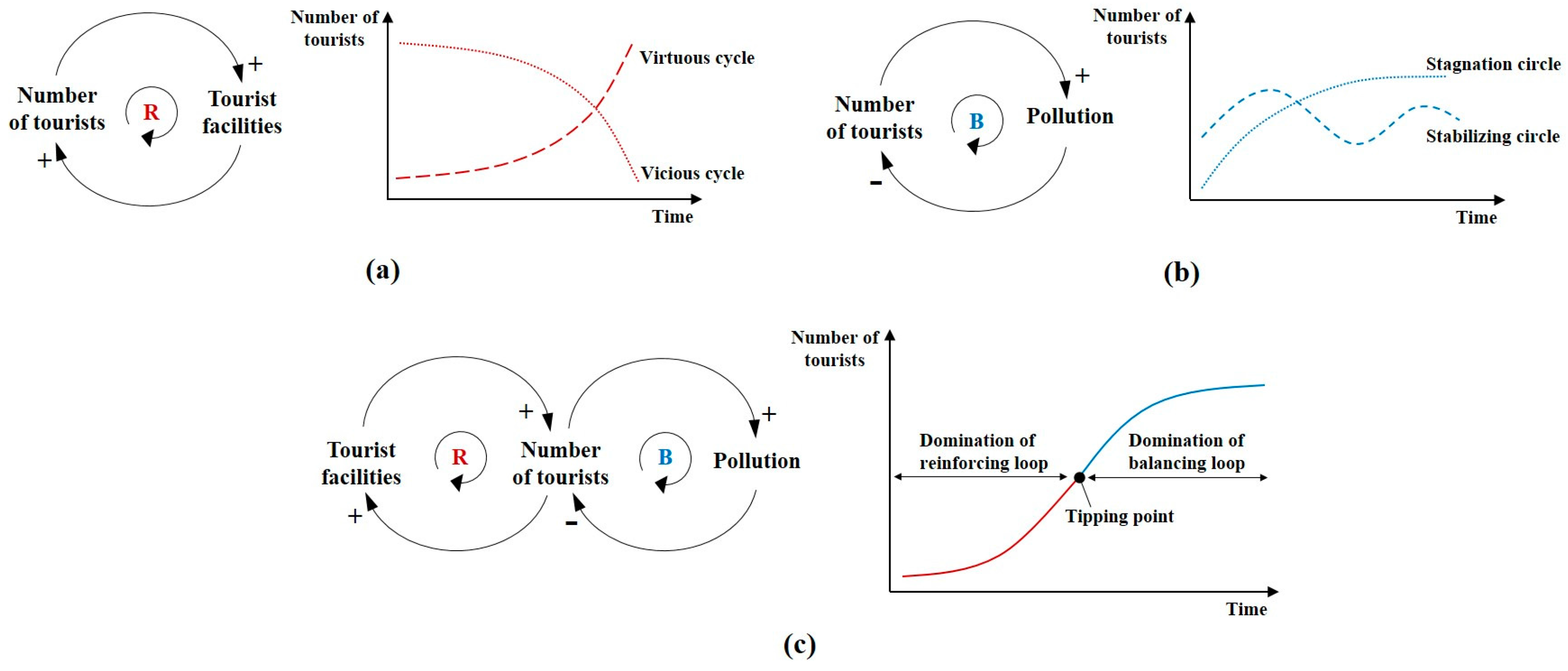
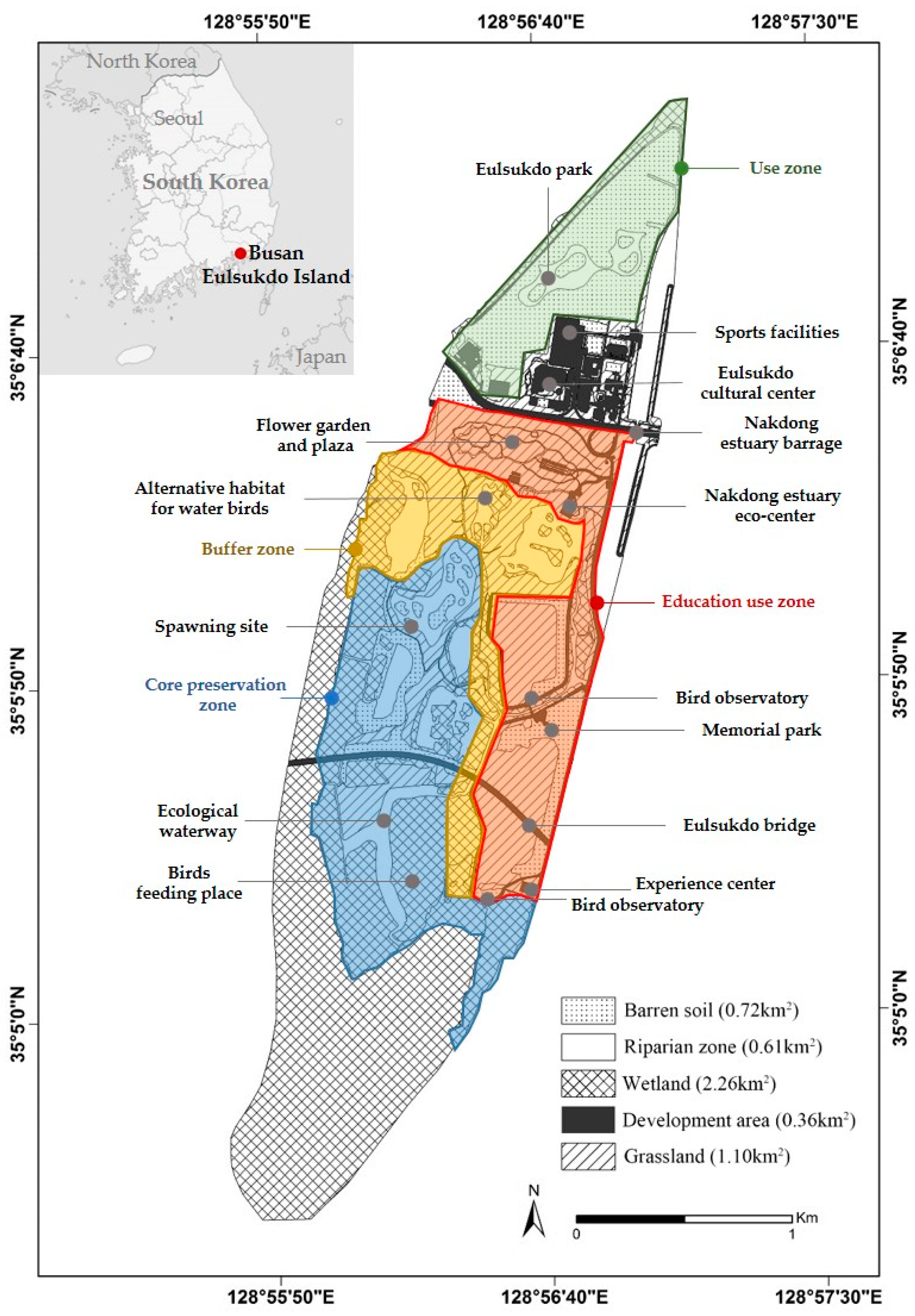
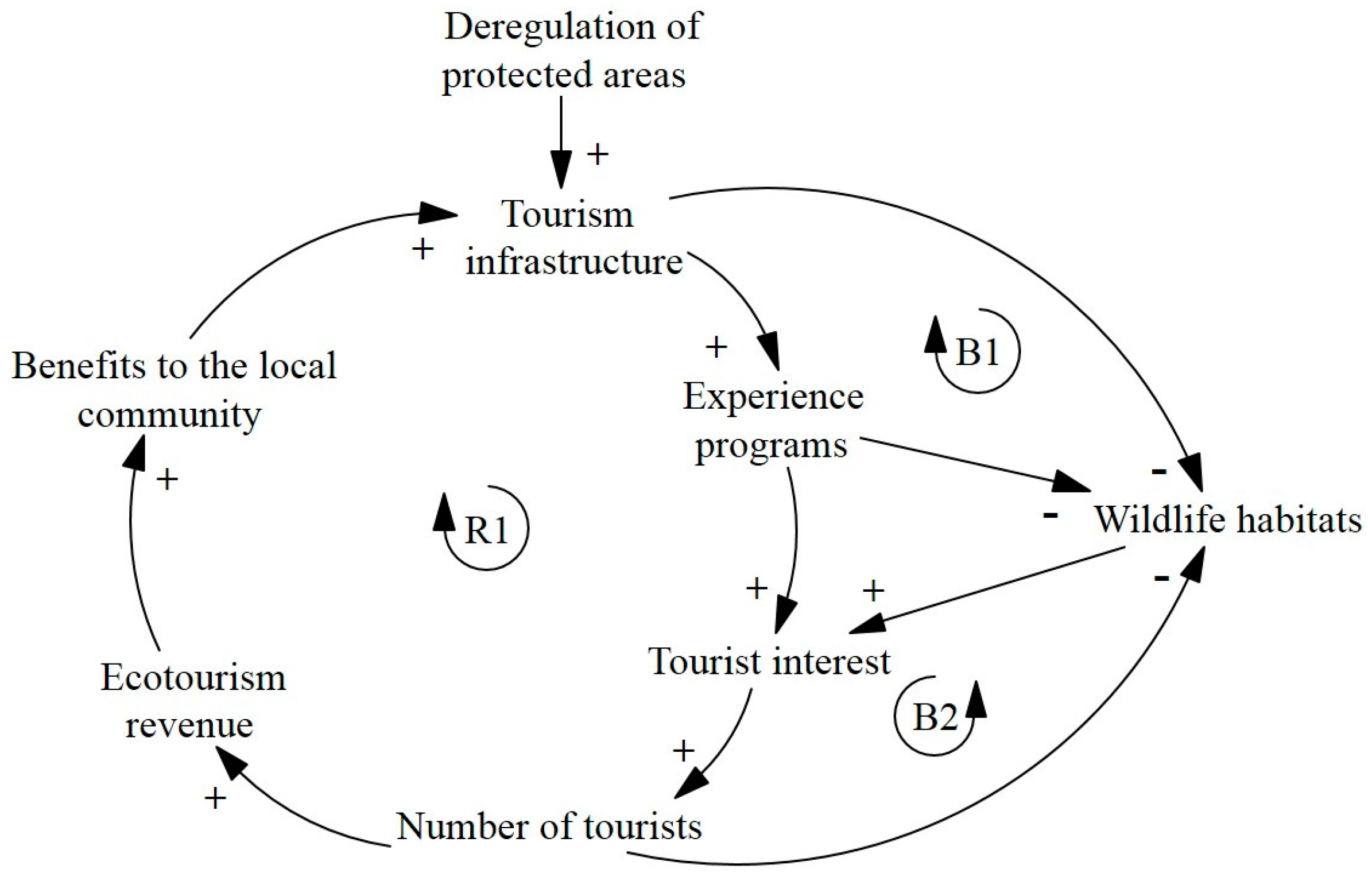
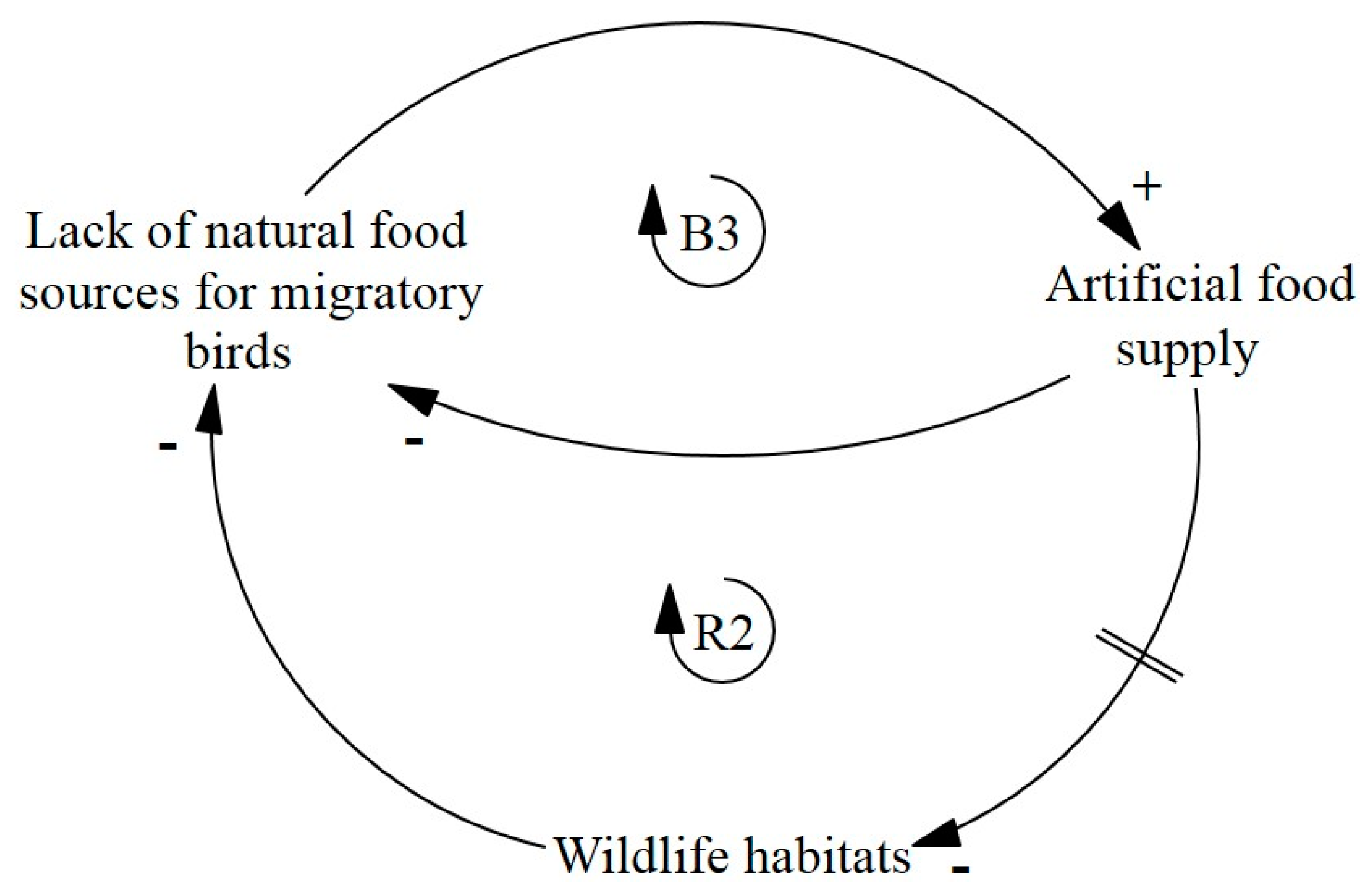

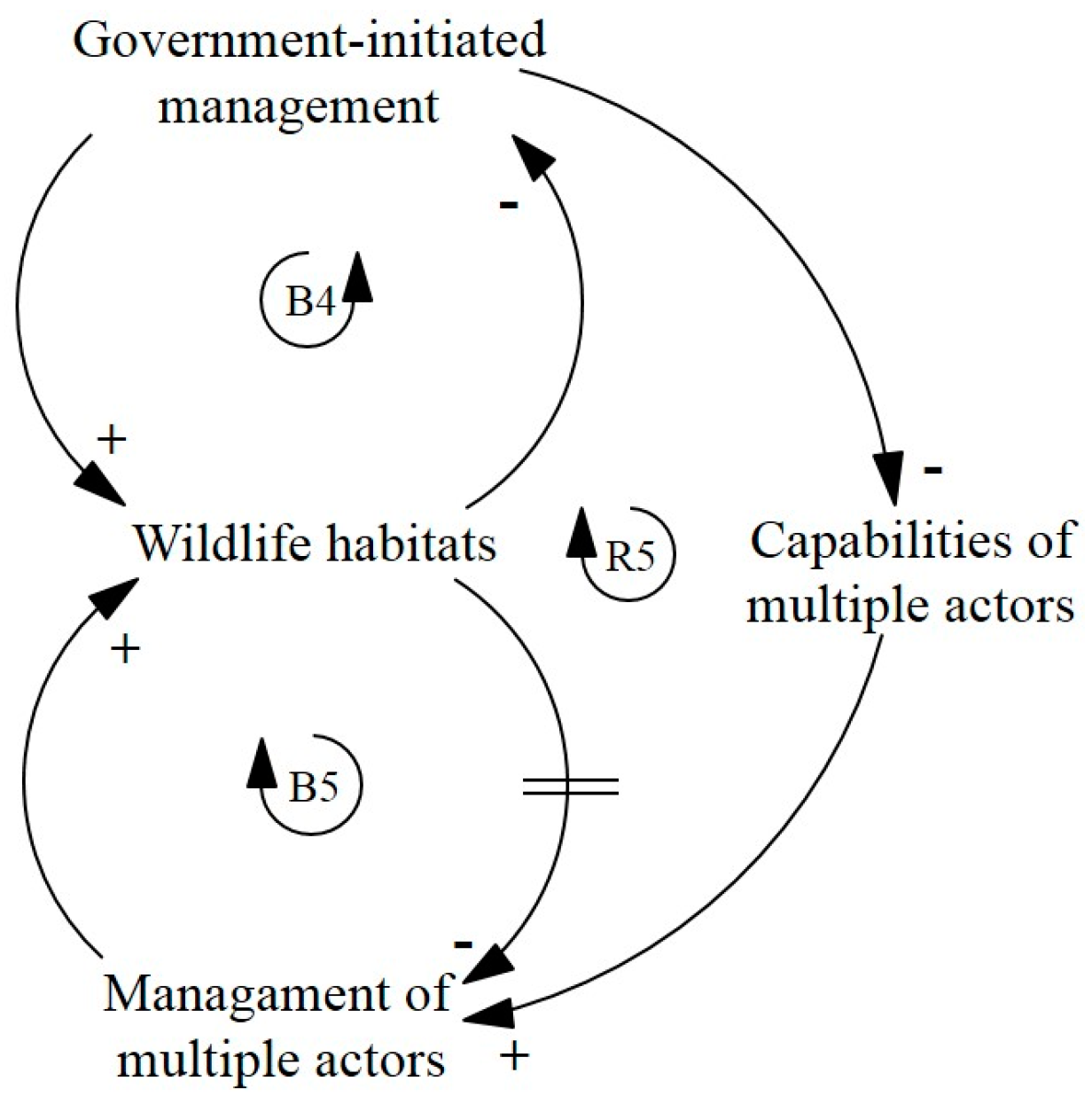

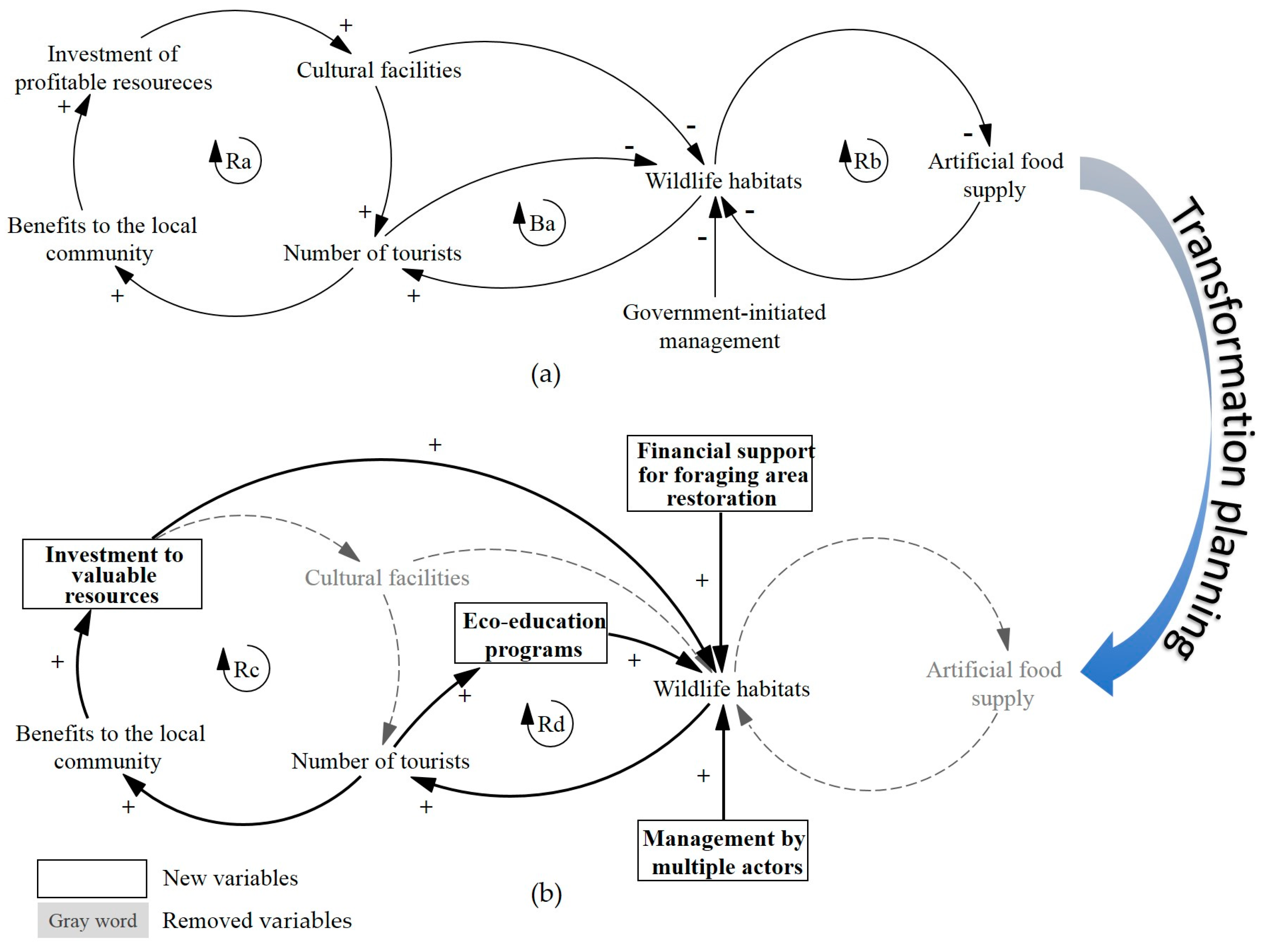
| Contents | Interview Questions |
|---|---|
| Ecotourism operation | What activities were used to promote ecotourism? What are the effects of tourism facilities and programs on habitats? |
| Management of wildlife habitats | What are your efforts to manage migratory birds and habitats? Why did the artificial food supply of migratory birds begin? What are the adverse effects or side effects of artificial food supplies for migratory birds? Did you try fundamental methods such as habitat restoration to secure migratory bird feed? |
| Visitor characteristics | What types of tourists are visiting? What is the difference between the characteristics of visitors to cultural facilities and those of ecotourists? |
| Multiple actors | Who are the stakeholders that are involved in Eulsukdo ecotourism? What efforts are being made by each stakeholder to maintain ecotourism in Eulsukdo? |
| Field | Categories | Stressor Activities | Stress Levels | Primary Response; Ecological Stress | Secondary Response (Reaction); Social Stress |
|---|---|---|---|---|---|
| Business | Facility management | Management of the Nakdong Estuary Eco-center, experience center, and Eulsukdo Culture Center | Middle | Habitat fragmentation Trampling of vegetation and soils Noise pollution | Decline in attractiveness of tourist site |
| Program management | Management of ecology experiences, ship tours, narrative exhibition programs | High | |||
| Environment | Facility construction | Construction of cultural-sports facilities and Eulsukdo Bridge | Middle | Decline in resilience of migratory birds Change in the populations of migratory birds | Expenditure in feeding birds Inactivity of ecological programs Decline in revenue from ecotourism |
| Preservation of bio-diversity | Manual feeding of migratory birds | High | |||
| Economy | Land use | Change in land use from protected area to development area | Middle | Change in the quality of habitat Indifference in ecological preservation | Cost-benefit imbalance |
| Re-investment of benefits | Large investment in the Eulsukdo Culture Center and sports facilities | High | |||
| Society | Utilizing local human resources | Dependence on short-term employees and volunteers Absence of local experts | Low | Change in habitat quality | Weakening of local qualities Reduction in the role of multiple actors Increases in time and cost necessary for ecosystem preservation |
| Participation in local community | Government-initiatedmanagement Failure to reflect the efforts of environment organizations and local community organizations to preserve Eulsukdo | High |
| Fields | Main Variables | Causal Link Mark | References 1 | |
|---|---|---|---|---|
| Independent Variable | Dependent Variable | |||
| Business | Deregulation of protected areas | Tourism infrastructure | + | NA and ID |
| Tourism infrastructure | Experience programs | + | ID | |
| Tourism infrastructure | Wildlife habitats | − | ID, MR, and NA | |
| Experience programs | Tourist attraction | + | ID | |
| Experience programs | Wildlife habitats | − | ID and LR | |
| Tourist interest | Number of tourists | + | RJ | |
| Wildlife habitats | Tourist attraction | + | ID and LR | |
| Number of tourists | Wildlife habitats | − | NA and LR | |
| Number of tourists | Ecotourism revenue | + | MR | |
| Ecotourism revenue | Benefits to the local community | + | LR | |
| Benefits to the local community | Tourism infrastructure | + | NA | |
| Environment | Lack of natural food sources for migratory birds | Artificial food supply | + | ID and MR |
| Artificial food supply | Lack of natural food sources for migratory birds | − | ID and MR | |
| Artificial food supply | Wildlife habitats | −, // | ID, NA, and LR | |
| Wildlife habitats | Lack of natural food sources for migratory birds | − | LR | |
| Economy | Ecotourism revenue | Benefits to the community | + | LR |
| Benefits to the community | Investment of profitable resources | + | ID | |
| Investment of profitable resources | Wildlife habitats | + | RJ | |
| Wildlife habitats | Tourist interest | + | ID and LR | |
| Tourist interest | Number of tourists | + | RJ | |
| Number of tourists | Ecotourism revenue | + | MR | |
| Ecotourism revenue | Benefits to the local community | + | LR | |
| Benefits to the local community | Investment of profitable resources | + | LR | |
| Investment of profitable resources | Cultural facilities | + | NA | |
| Cultural facilities | Satisfaction of local residents | + | NA | |
| Satisfaction of local residents | Utilization of local residents | + | RJ | |
| Utilization of local residents | Cultural facilities revenue | + | LR | |
| Cultural facilities revenue | Benefits to the community | + | LR and NA | |
| Society | Government-initiated management | Wildlife habitats | + | MR |
| Wildlife habitats | Government-initiated management | − | ID | |
| Management of multiple actors | Wildlife habitats | + | ID | |
| Wildlife habitats | Management of multiple actors | −, // | ID | |
| Government-initiated management | Capabilities of multiple actors | − | LR | |
| Capabilities of multiple actors | Management of multiple actors | + | LR and RJ | |
© 2017 by the authors. Licensee MDPI, Basel, Switzerland. This article is an open access article distributed under the terms and conditions of the Creative Commons Attribution (CC BY) license (http://creativecommons.org/licenses/by/4.0/).
Share and Cite
Choi, Y.E.; Song, K.; Kim, M.; Lee, J. Transformation Planning for Resilient Wildlife Habitats in Ecotourism Systems. Sustainability 2017, 9, 487. https://doi.org/10.3390/su9040487
Choi YE, Song K, Kim M, Lee J. Transformation Planning for Resilient Wildlife Habitats in Ecotourism Systems. Sustainability. 2017; 9(4):487. https://doi.org/10.3390/su9040487
Chicago/Turabian StyleChoi, Yun Eui, Kihwan Song, Min Kim, and Junga Lee. 2017. "Transformation Planning for Resilient Wildlife Habitats in Ecotourism Systems" Sustainability 9, no. 4: 487. https://doi.org/10.3390/su9040487






